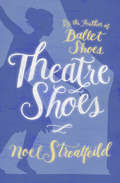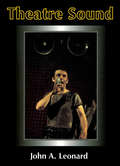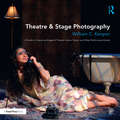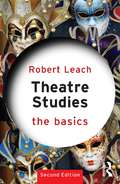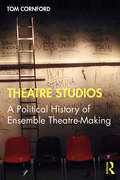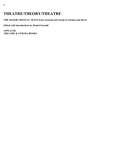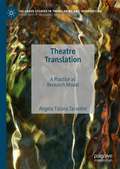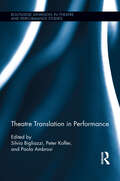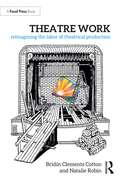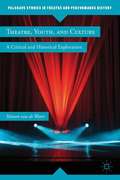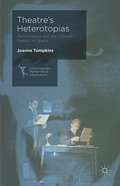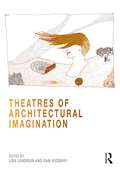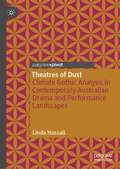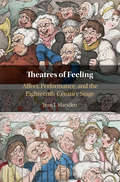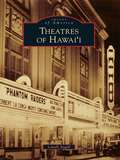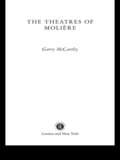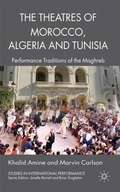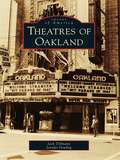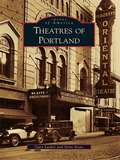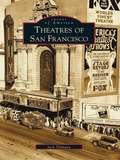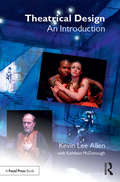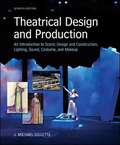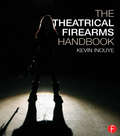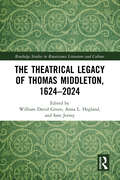- Table View
- List View
Theatre Shoes (Shoes #3)
by Noel StreatfeildThis captivating companion to Ballet Shoes tells the story of 3 orphans who become students at a famous theatre school After their father disappeared in the war, Sorrell, Holly, and Mark Forbes were sent to live with their grandfather. When he dies, the three orphans are on the move again—this time to London, where their maternal grandmother is a well-known actress. The city is a strange, bustling place that frightens young Holly, but the siblings&’ new home at 14 Ponsonby Square has a garden that instantly enchants them. Their grandmother enrols them at the Children&’s Academy of Dancing and Stage Training, where they&’ll carry on the tradition of their famous theatre family, which includes cousins they never knew they had. Stuck-up Miranda thinks she can act better than Sorrel; homesick Mark discovers he can sing; and Holly is a natural dancer. Will Sorrel, Holly, and Mark live up to their family legacy?
Theatre Sound
by John A. LeonardTheatre Sound includes a brief history of the use of sound in the theatre, discussions of musicals, sound effects, and the recording studio, and even an introduction to the physics and math of sound design. A bibliography and online reference section make this the new essential work for students of theatre and practicing sound designers.
Theatre & Stage Photography: A Guide to Capturing Images of Theatre, Dance, Opera, and Other Performance Events
by William KenyonDocumenting theatrical and stage events under the often dramatic lighting designed for the production provides a number of specific photographic challenges, and is unlike most every other branch of photography. Theatre & Stage Photography provides an overview of basic photography as it applies to "available-light" situations, and will move both basic and experienced photographers through the process of accurately capturing both the production process and the resultant performance. The book is accompanied by additional web content found at stagephoto.org, including tutorials, author blog, a photo gallery, and more resources.
Theatre Studies: The Basics (The Basics)
by Robert LeachNow in a second edition, Theatre Studies: The Basics is a fully updated guide to the wonderful world of theatre. The practical and theoretical dimensions of theatre – from acting to audience – are woven together throughout to provide an integrated introduction to the study of drama, theatre and performance. Topics covered include: dramatic genres, from tragedy to political documentary theories of performance the history of the theatre in the West acting, directing and scenography With a glossary, chapter summaries and suggestions for further reading throughout, Theatre Studies: the Basics remains the ideal starting point for anyone new to the subject.
Theatre Studios: A Political History of Ensemble Theatre-Making
by Tom CornfordTheatre Studios explores the history of the studio model in England, first established by Konstantin Stanislavsky, Jacques Copeau and others in the early twentieth century, and later developed in the UK primarily by Michel Saint-Denis, George Devine, Michael Chekhov and Joan Littlewood, whose studios are the focus of this study. Cornford offers in-depth accounts of the radical, collective work of these leading theatre companies of the mid-twentieth century, considering the models of ensemble theatre-making that they developed and their remnants in the newly publicly-funded UK theatre establishment of the 1960s. In the process, this book develops an approach to understanding the politics of artistic practices rooted in the work of John Dewey, Antonio Gramsci and the standpoint feminists. It concludes by considering the legacy of the studio movement for twenty-first-century theatre, partly by tracking its echoes in the work of Secret Theatre at the Lyric, Hammersmith (2013–2015). Students and makers of theatre alike will find in this book a provocative and illuminating analysis of the politics of performance-making and a history of the theatre as a site for developing counterhegemonic, radically democratic, anti-individualist forms of cultural production.
Theatre/Theory/Theatre: The Major Critical Texts From Aristotle and Zeami to Soyinka and Havel (Applause Books)
by Daniel GerouldFrom Aristotle's Poetics to Vaclav Havel, the debate about the nature and function of theatre has been marked by controversy. Daniel Gerould's landmark work, Theatre/Theory/Theatre, collects history's most influential Eastern and Western dramatic theorists—poets, playwrights, directors and philosophers—whose ideas about theatre continue to shape its future. <p><p>In complete texts and choice excerpts spanning centuries, we see an ongoing dialogue and exchange of ideas between actors and directors like Craig and Meyerhold, and writers such as Nietzsche and Yeats. Each of Gerould's introductory essays shows fascinating insight into both the life and the theory of the author. From Horace to Soyinka, Corneille to Brecht, this is an indispensable compendium of the greatest dramatic theory ever written.
Theatre Translation: A Practice as Research Model (Palgrave Studies in Translating and Interpreting)
by Angela Tiziana TarantiniThis book examines the effects of translation on theatrical performance. The author adapts and applies Kershaw et al.’s Practice as Research model to an empirical investigation analysing the effects of translation on the rhythm and gesture of a playtext in performance, using the contemporary plays Convincing Ground and The Gully by Australian playwright David Mence which have been translated into Italian. The book is divided into two parts: a theoretical exegesis encompassing Translation Studies, Performance Studies and Gesture Studies, and a practical investigation comprising of a workshop where excerpts of the plays are explored by two groups of actors. The chapters are accompanied by short clips of the performance workshop hosted on SpringerLink. The book will be of interest to students and scholars in the fields of Translation Studies (and Theatre Translation more specifically), Theatre and Performance, and Gesture Studies.
Theatre Translation in Performance (Routledge Advances in Theatre & Performance Studies #29)
by Silvia Bigliazzi Peter Kofler Paola AmbrosiThis volume focuses on the highly debated topic of theatrical translation, one brought on by a renewed interest in the idea of performance and translation as a cooperative effort on the part of the translator, the director, and the actors. Exploring the role and function of the translator as co-subject of the performance, it addresses current issues concerning the role of the translator for the stage, as opposed to the one for the editorial market, within a multifarious cultural context. The current debate has shown a growing tendency to downplay and challenge the notion of translational accuracy in favor of a recreational and post-dramatic attitude, underlying the role of the director and playwright instead. This book discusses the delicate balance between translating and directing from an intercultural, semiotic, aesthetic, and interlingual perspective, taking a critical stance on approaches that belittle translation for the theatre or equate it to an editorial practice focused on literality. Chapters emphasize the idea of dramatic translation as a particular and extremely challenging type of performance, while consistently exploring its various textual, intertextual, intertranslational, contextual, cultural, and intercultural facets. The notion of performance is applied to textual interpretation as performance, interlingual versus intersemiotic performance, and (inter)cultural performance in the adaptation of translated texts for the stage, providing a wide-ranging discussion from an international group of contributors, directors, and translators.
Theatre Work: Reimagining the Labor of Theatrical Production
by Brídín Clements Cotton Natalie RobinTheatre Work: Reimagining the Labor of Theatrical Production investigates both the history and current realities of life and work in professional theatrical production in the United States and explores labor practices that are equitable, accessible, and sustainable.In this book, Brídín Clements Cotton and Natalie Robin investigate the question of artmaking, specifically theatrical production, as work. When the art is the work, how do employers navigate the balance between creative freedom and these equitable, accessible, and sustainable personnel processes? Do theatrical production operations value the worker? Through data analyses, worker narratives, and analogues to the evolving gig economy, Theatre Work questions everything about theatrical production work – including our shared history, ways of operating, and assumptions about how theatre is made – and considers what might happen if the American Theatre was reborn in an entirely new form.Written for members of the theatrical production workplace, leaders of theatrical institutions and productions, labor organizers, and industry union leaders, Theatre Work: Reimagining the Labor of Theatrical Production speaks to the ways that employers and workers can reimagine how we work.
Theatre, Youth, and Culture
by Manon van de WaterThere is a complex relationship between performance, youth, and the shifting material circumstances (social, cultural, economic, ideological, and political) under which theatre for children and youth birth through twenties is generated and perceived. Offering multiple, intersecting narratives, this book explores different aspect of theatre for young audiences (TYA) using examples from theatrical events in different geographical regions. The discussion of the history, theory, and practice of TYA indicates the wide variety of hitherto under-researched topics in the growing field of professional theatre for young people. "
Theatre’s Heterotopias
by Joanne TompkinsTheatre's Heterotopias articulates a new methodology for interpreting a space (including architectural, narrative, imaginative, and imaginary) in theatre and performance. A heterotopia is an 'alternative space' that is distinguished from that actual world, but that resonates with it. The value in applying heterotopia to theatre is that in performance, we can actually witness how else space and place might be constituted: it is the point of comparison of what does occur against what else might transpire such that the 'unreal' spaces that comprise a theatrical experience have the capacity to elicit concrete effects beyond its walls. A heterotopia is a technique for exploring theatrical space that affords a better understanding of the theatrical experience, the context in which performance takes place, and the power and knowledge that shape its socio-political context. The book's case studies include site-specificity, selected productions from the National Theatre of Scotland and Shakespeare's Globe, and multimedia performance.
Theatres of Architectural Imagination
by Lisa LandrumThis volume explores connections between architecture and theatre, and encourages imagination in the design of buildings and social spaces. Imagination is arguably the architect’s most crucial capacity, underpinning memory, invention, and compassion. No simple power of the mind, architectural imagination is deeply embodied, social, and situational. Its performative potential and holistic scope may be best understood through the model of theatre. Theatres of Architectural Imagination examines the fertile relationship between theatre and architecture with essays, interviews and entr’actes arranged in three sections: Bodies, Settings, and (Inter)Actions. Contributions explore a global spectrum of examples and contexts, from ancient Rome and Renaissance Italy to modern Europe, North America, India, Iran, and Japan. Topics include the central role of the human body in design; the city as a place of political drama, protest, and phenomenal play; and world-making through language, gesture, and myth. Chapters also consider sacred and magical functions of theatre in Balinese and Persian settings; eccentric experiments at the Bauhaus and 1970 Osaka World Expo; and ecological action and collective healing amid contemporary climate chaos. Inspired by architect and educator Marco Frascari, the book performs as a Janus-like memory theatre, recalling and projecting the architect’s perennial task of reimagining a more meaningful world. This collection will delight and provoke thinkers and makers in theatrical arts and built environment disciplines, especially architecture, landscape, and urban design.
Theatres of Dust: Climate Gothic Analysis in Contemporary Australian Drama and Performance Landscapes
by Linda HassallThrough a contemporary Gothic lens, the book explores theatre theories, processes and practices that explore; the impacts of continuing drought and natural disaster, the conflicts concerning resource extraction and mining and current political debates focussed on climate change denial. While these issues can be argued from various political and economic platforms, theatrical investigations as discussed here suggest that scholars and theatre makers are becoming empowered to dramaturgically explore the ecological challenges we face now and may face in the future. In doing so the book proposes that theatre can engage in not only climate change analysis and discussion but can develop climate literacies in a broader socio-cultural context.
Theatres of Feeling: Affect, Performance, and the Eighteenth-Century Stage
by Jean I. MarsdenTheatre and theatregoing was central to the cultural life of later eighteenth-century Britain. In this engaging work, Jean I. Marsden explores the playhouse as a source of emotion during a period when the ability to feel demonstrated moral worth. Using first-hand accounts, reviews, and illustrations to complement the drama of the era, Marsden examines why both critics and audiences elevated the theatre above the pulpit and how they experienced the plays and performances that they witnessed. Tears and even fainting fits were a common reaction to powerful productions, and playwrights sought to harness this emotion. The book explores this intersection of text, performance, and affect in a series of case studies of plays exploring British liberty, empire and the evils of antisemitism. With a focus on emotional response, Theatres of Feeling delivers a new approach to dramatic literature and performance, one that moves beyond more limited studies of text or performance.
Theatres of Hawai'i
by Lowell AngellFamous for its lush beauty and inviting beaches, Hawai'i also boasts a rich theatrical history dating back to the mid-19th century and spanning its years as a kingdom, U.S. territory, and a state. Its warm, tropical climate and social, cultural, and ethnic diversity contributed to the variety of theatres unique to the islands--from simple, rural plantation theatres on the neighbor islands, to neighborhood movie houses in exotic styles, to an incomparable tropical moderne jewel near the beach at Waikiki. Most of these theatres are now just a memory, except for those few saved by dedicated individuals and restored for another life. This book celebrates the rich history of these theatrical venues through rare archival photographs and little-known details.
The Theatres of Moliere (Theatre Production Studies)
by Gerry McCarthy Gerry MccarthyMoliere's plays are the cornerstone of the French Classical dramatic repertoire. Adapted and exploited in his day by dramatists of the English Restoration, they are now again growing in popularity. In this detailed and fascinating volume, Gerry McCarthy examines the practice and method of possibly the greatest actor-dramatist. From the rough farces of Moliere's days on the road to the creation of the diverse and spectacular court entertainments on his return to Paris, McCarthy sheds new light on the dramatic intelligence and theatrical understanding of Moliere's writing for the actor. Drawing on Moliere's own brief discussions of performance and the contemporary evidence of his practice, this is a crucial addition to the debate on style and method in classical acting and on the staging of classical plays on the contemporary stage.
The Theatres of Morocco, Algeria and Tunisia
by Khalid Amine Marvin CarlsonModern international studies of world theatre and drama have begun to acknowledge the Arab world only after the contributions of Asia, Africa and Latin America. Within the Arab world, the contributions of Algeria, Tunisia, and Morocco to modern drama and to post-colonial expression remain especially neglected, a problem that this book addresses.
Theatres of Oakland
by Jennifer Dowling Jack TillmanyOakland has a rich theatre history, from the amusements of a gas-lit downtown light opera and vaudeville stage in the 1870s to the ornate cinematic escape portals of the Great Depression. Dozens of neighborhood theatres, once the site of family outings and first dates, remain cherished memories in the lives of Oaklanders. The city can still boast three fabulous movie palaces from the golden age of cinema: the incomparable art deco Paramount, which now offers live performances and films; the stately Grand Lake gracing the sinuous shores of Lake Merritt; and the magnificently eccentric Fox Oakland, with its imposing Hindu gods flanking the stage. The Paramount and Grand Lake still stir the heartstrings of patrons with showings preceded by interludes on their mighty Wurlitzer organs.
Theatres of Portland
by Steve Stone Gary LacherPortland's theatre history is marked by early enthusiasm and exceptionally vigorous growth. With the Pacific Northwest's often rainy weather, people sought refuge in movie entertainment, and the city eventually grew to have more theatre seats per capita than similar-sized cities in the United States. Beginning with short cinema segments at vaudeville houses downtown, Portland movie theatres came into their own swiftly and ambitiously. By 1915, there were over 70 individual theatres showing films both downtown and in neighborhoods throughout the city. By the 1920s, larger theatres were being built, including substantial neighborhood palaces such as the Bagdad, Hollywood, and Oriental. Meanwhile, downtown provided the Broadway, Portland, and Orpheum, to name a few. This volume contains an overview of Portland's theatre history through rare and newly discovered historical photographs of those memorable places of entertainment.
Theatres of San Francisco
by Jack TillmanyYou read the sad stories in the papers: another ornate, 1920s, single-screen theatre closes, to be demolished and replaced by a strip mall. That's progress, and in this 20-screen multiplex world, it's happening more and more. Only a handful of the 100 or so neighborhood theatres that once graced these streets are left in San Francisco, but they live on in the photographs featured in this book. The heyday of such venues as the Clay, Noe, Metro, New Mission, Alexandria, Coronet, Fox, Uptown, Coliseum, Surf, El Rey, and Royal was a time when San Franciscans thronged to the movies and vaudeville shows, dressed to the hilt, to see and be seen in majestic art deco palaces. Unfortunately, this era has passed into history despite the dedicated efforts of many neighborhood preservation groups.
Theatrical Design: An Introduction
by Kevin Lee AllenA theatrical designer must address two questions when designing a production: What is the play about and what is the play like? To find the metaphor within a play is to unlock inspired and unique design concepts. Theatrical Design: An Introduction is about how to find the design idea for a production and what to do with that idea once identified. This book emphasizes script analysis and interpretation specifically for designers: how to release meaning and design inspiration from lines and characterization in a script. It then explains the artistic elements and principles of design—the skills necessary to create the design visualized. Concepts are illustrated with examples from theatre, film, art, architecture, and fashion that explore professional and historic use of conceptualization and metaphor. Theatrical Design: An Introduction imparts the tools designers need to innovate off the page.
Theatrical Design And Production: An Introduction To Scene Design And Construction, Lighting, Sound, Costume, And Makeup
by J. GilletteTheatrical Design and Production is a comprehensive and practical survey that examines the technical and design aspects of play production, including scene design and construction, lighting, sound, costume, and makeup. Design is presented as both an art closely integrated with the director’s, actor’s, and playwright’s visions, and a craft that provides practical solutions for the physical manipulation of stage space.
The Theatrical Event: A Mythos, A Vocabulary, A Perspective
by David ColeDavid Cole explains what the theatrical event is and is not. To do this, he presents aspects of the theater’s devolvement, explains the contributions of the actor, the audience, scenic design. He also describes the ways in which the modern theater has departed from the author’s description of the theatrical event. He provides support for his themes by drawing on many religious and psychological theories and by examining the works of numerous playwrights.
The Theatrical Firearms Handbook
by Kevin InouyeThe Theatrical Firearms Handbook is the essential guide to navigating the many decisions that are involved in the safe and effective use of firearm props for both the stage and screen. It is an invaluable resource for fight choreographers, props designers, backstage crew, directors, actors, stage managers, and more, at all levels of experience. Written in an informal and entertaining manner, with over 100 illustrations, it establishes baseline safety protocol while empowering performers and designers to tell their story of conflict in a way that makes the most of both established convention and current tools of the trade. Within these pages you'll find practical instruction couched in the language of theatre and film, making firearms technology and concepts approachable to dramatic artists without any dumbing-down of the subject material. This handbook is equally at home within the worlds of academic training, professional performance, and independent or community theatre and video productions.
The Theatrical Legacy of Thomas Middleton, 1624–2024 (Routledge Studies in Renaissance Literature and Culture)
by William David Green Anna L. Hegland Sam JermyThis volume celebrates Thomas Middleton’s legacy as a dramatist, marking the 400th anniversary of Middleton’s final and most contentious work for the public theatres, A Game at Chess (1624).The collection is divided into three sections: ‘Critical and Textual Reception’, ‘Afterlives and Legacies’, and ‘Practice and Performance’. This division reflects the book’s holistic approach to Middleton’s canon, and its emphasis on the continuing significance of Middleton’s writing to the study of early modern English drama. Each section offers an assessment of the place of Middleton’s drama in culture, criticism, and education today through a range of critical approaches.Featuring work from a range of voices (from early career, independent, and seasoned academics and practitioners), the collection will be appropriate for both specialists in early modern literature and drama who are interested in both theory and practice, and students or scholars researching Middleton’s historical significance to the study of early theatre.
